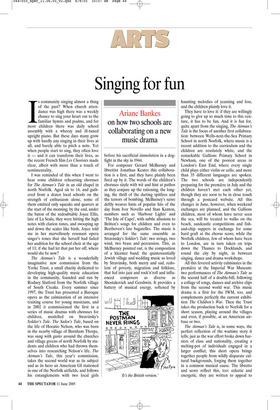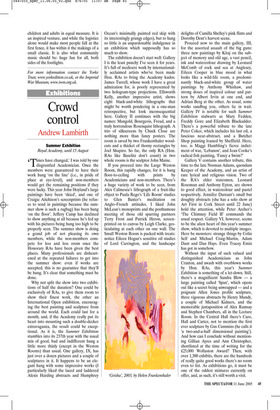Singing for fun
Ariane Bankes on how two schools are collaborating on a new music drama
Is community singing almost a thing of the past? When church attendance was high there was a weekly chance to sing your heart out to the familiar hymns and psalms, and for most children there was daily school assembly with a wheezy and ill-tuned upright piano. But these days many grow up with hardly any singing in their lives at all, and barely able to pitch a note. Yet when people start to sing, they often love it — and it can transform their lives, as the recent French film Les Choristes made clear, albeit with more than a touch of sentimentality.
I was reminded of this when I went to hear some children rehearsing choruses for The Airman’s Tale in an old chapel in north Norfolk. Aged six to 14, and gathered from a dozen local schools on the strength of enthusiasm alone, some of them emitted only squeaks and quavers at the start of the morning; by the end, under the baton of the redoubtable Joyce Ellis, late of La Scala, they were hitting the high notes with clarion tones, and swooping up and down the scales like birds. Joyce told me in her marvellously resonant opera singer’s tones that she herself had failed her audition for the school choir at the age of 11; if she had let that put her off, where would she be now?
The Airman’s Tale is a wonderfully imaginative new commission from the Yorke Trust, a small charity dedicated to developing high-quality music education in the community, founded and run by Rodney Slatford from the Norfolk village of South Creake. Every summer since 1997, the Trust has presented a Baroque opera as the culmination of an intensive training course for young musicians, and in 2002 it commissioned the first in a series of music dramas with choruses for children, modelled on Stravinsky’s Soldier’s Tale. The Sailor’s Tale, based on the life of Horatio Nelson, who was born in the nearby village of Burnham Thorpe, was sung with gusto around the churches and village greens of north Norfolk by students and children who had thrown themselves into researching Nelson’s life. The Airman’s Tale, this year’s commission, takes the second world war as its subject and as its hero an American GI stationed in one of the Norfolk airfields, and follows his entanglements with two local girls before his sacrificial immolation in a dogfight in the sky in 1944.
For composer Gerard McBurney and librettist Jonathan Keates this collaboration is a first, and they have plainly been fired up by it. The words of the children’s choruses sizzle with wit and hint at pathos as they conjure up the rationing, the longing, the thrill of the darting spitfires and the terrors of bombing. McBurney’s score deftly weaves hints of popular hits of the day from Ivor Novello and Stan Kenton, numbers such as ‘Harbour Lights’ and ‘The Isle of Capri’, with subtle allusions to Britten’s songs for children and even to Beethoven’s late bagatelles. The music is arranged for the same ensemble as Stravinsky’s Soldier’s Tale: two strings, two wind, two brass and percussion. This, as McBurney pointed out, is the composition of a klezmer band: the quintessentially Jewish village and wedding music so loved by Stravinsky, both merry and sad, redolent of poverty, migration and folklore, that fed into jazz and rock’n’roll and influenced composers as diverse as Shostakovich and Gershwin. It provides a battery of musical energy, softened by haunting melodies of yearning and loss, and the children plainly love it.
They have to love it: if they are willingly going to give up so much time to this venture, it has to be fun. And it is fun for, quite apart from the singing, The Airman’s Tale is the focus of another first collaboration: between Wells-next-the-Sea Primary School in north Norfolk, where music is a recent addition to the curriculum and the children are resolutely white, and the remarkable Gallions Primary School in Newham, one of the poorest areas in London’s East End, where every single child plays either violin or cello, and more than 35 different languages are spoken. The two schools are independently preparing for the première in July and the children haven’t met each other yet, though they are soon to be in close touch through a postcard website. All this changes in June, however, when weekend exchanges are planned, and the Gallions children, most of whom have never seen the sea, will be treated to walks on the beach, sandcastle competitions and fishand-chip suppers in exchange for some hard graft at the chorus score, while the Norfolk children, few of whom have been to London, are in turn taken on trips down the Thames to Docklands, and round the city by night, in between singing, dance and drama workshops.
All this fevered activity culminates in the première at the Imperial War Museum: two performances of The Airman’s Tale as the second half of a double-bill, following a collage of songs, dances and archive clips from the second world war. This music drama is a first for the IWM, too, and complements perfectly the current exhibition The Children’s War. Then the Trust takes the production back to Norfolk for a short season, playing around the villages and even, if possible, at an American airbase or two.
The Airman’s Tale is, in some ways, the perfect reflection of the wartime story it tells: just as the war effort broke down barriers of class and nationality, creating a melting-pot of individuals engaged in a larger conflict, this short opera brings together people from wildly disparate cultural backgrounds, forging them together in a common musical cause. The libretto and score reflect this, too: eclectic and energetic, they are written to appeal to children and adults in equal measure. It is an inspired venture, and while the logistics alone would make most people fall at the first fence, it has within it the makings of a small classic. It is also what community music should be: huge fun for all, both sides of the footlights.



















































 Previous page
Previous page